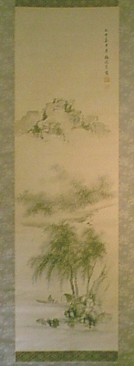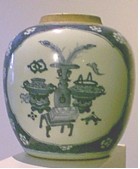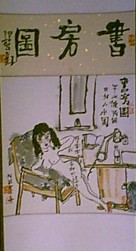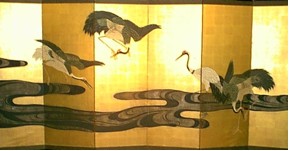THE ART COLLECTION INTERESTS OF
JOHN BYRON
Besides collecting Chinese erotica, I have also been interested in oriental art more broadly, acquiring both Chinese and Japanese pieces. This collection is quite eclectic in character, and includes traditional scroll paintings and calligraphy, modernistic works by contemporary artists, Ming and Qing Dynasty porcelain, and traditional Chinese carpets. The very few examples illustrated here give a sense of the variety of this collection.
JAPANESE PAINTING ON SILK OF A LADY WITH A BIRD
Early twentieth century painting of a geisha or traditionally dressed Japanese beauty. Painted and signed by Senen, or "Clear Garden". His background is obscure, and was probably a professional painter during the late Meiji period who was cashing in on the rise of nationalist sentiment in Japan that was occurring during the 1890s and early 1910s
JAPANESE BUJINGA LANDSCAPE PAINTING
During the eighteenth and early nineteenth centuries the Chinese style of landscape painting --- known as "scholar paintings", wenrenhua in Chinese or bujinga in Japanese --- enjoyed a revival in Japan. This work is a typical example of that period. Painted by Baiitsu (1783-1856), who was born in Nagoya and studied traditional Chinese style painting in Kyoto. He was a prolific artist and his works today are featured in many international art galleries, including the Freer Art Gallery in Washington DC.
This painting is dated 1833. It is complete with all the original brocade facing and ivory scroll mounts.
LANDSCAPE BY JAPANESE PAINTER, SEKKO
Chinese-style landscape painting by Sekko, an Edo or Tokyo-based painter who lived from 1806 to 1847. This painting is typical of the Chinese-style painting , with a strong lyrical element and sense of humour, which enjoyed great popularity in both China and Japan during the first half of the nineteenth century.
Purchased in Taipei in 1972.
CALLIGRAPHY BY FEI XINWO, FAMOUS TWENTIETH CENTURY ARTIST
Calligraphy specially written by Fei Xinwo, a famous twentieth century Chinese painter and calligrapher, for Yan Zhen, the well-known modern Chinese poet and painter. The characters are a couplet of poetry which reads
"One crane in a sky so clear that it seemed to soar above the clouds
And brought the mood of poetry to the azure heavens."
Fei Xinwo was born in 1903 at Wuxing in Zhejiang. He was renowned for his traditional-style paintings as well as his calligraphy. He was a member of the Jiangsu Province Art Academy.
PAINTING OF BAMBOO BY XIE ZHILIU
An elegant ink painting of bamboo done by Xie Zhiliu when John Byron visited him at his home in Shanghai in 1993.
Xie Zhiliu, who was born in Jiangsu Province in 1910, was the most famous Shanghai-based painter of the twentieth century. He died in Shanghai in 1998, by which time he had become a major figure in the world of modern Chinese art. He worked in the Shanghai Museum, and was also much sought after as an expert connoisseur who could authoritatively assess the authenticity of traditional Chinese paintings.
BLUE AND WHITE GINGER JAR WITH PANELS DEPICTING HOUSEHOLD FURNITURE
Designed and decorated with all the features of a Kangxi period (1662-1723) ginger jar, but almost certainly a nineteenth century imitation. The pictorial decorations depict low tables, incense burners, and vases, all of which were part of the environment in the home of an affluent family.
EARLY QING DYNASTY BLUE AND WHITE MEIPING OR BLOSSOM VASE
An early Qing Dynasty blue and white porcelain vase dating from approximately 1650 through 1700. The rim of the vase has been very carefully ground down as a consequence of damage done to the mouth of the vase. The repair displays a clear patina of age and was executed with considerable skill, confirming that a previous owner regarded this meiping vase, originally designed to hold a sprig or two of blossom, as a valuable item.
KANGXI PERIOD BLUE AND WHITE PORCELAIN JAR
Underglaze blue and white porcelain jar made during the second half of the seventeenth century. An excellent example of Kangxi period porcelain.
NUDE WITH A LIZARD
Contemporary painting of a nude with a lizard climbing up the vermillion coloured pillar. Painting unsigned, but believed to be the work of Peng Ingcai, an artist currently working in Beijing.
MODERN CHINESE SATIRICAL PAINTING
This picture of a naked girl in a study, entitled "Picture of the Library", is an example of the satirical art that is being produced in contemporary Beijing. The characters written across the torso of the subject read, "apart from having to eat I am like an immortal".
Painted by "Ah Min", which is presumably the art name of a contemporary Chinese painter working in Beijing.
THE FACES OF TIME
Contemporary Chinese painting by Yan Zhen, one-time chairman of the Anhui Writers Association and author of many other works, including the best-selling travel book, "I Tell You A Real Australia".
Born in Shandong Province in 1930, Yan Zhen is a highly successful poet and painter. He has exhibited his paintings both abroad and in China, including a major exhibition at the National Art Gallery in Beijing.
This painting was featured on the cover of Open Your Eyes to Sleep, a collection of Chinese short stories that was published in Beijing in 2000. According to the artist, the meaning he sought to convey in this painting was the small and insignificant character of the life of individuals in the face of time.
ZHONG KUI PLAYING CHESS WITH A DEVIL
Painting by Wu Duo, a student of Fan Zeng, the most celebrated of late twentieth century Chinese painters. Fan Zeng made a career out of painting figures from Chinese mythology and history, and passed this approach on to his students, as is shown in this painting.
This painting depicts Zhong Kui, who in Chinese legend is regarded as the Protector against Evil Spirits, playing chess with a demon who wants to escape from the Taoist hell. The Zhong Kui legend originated in the ninth century, when the Tang emperor Ming Huang was protected from a demon named Xu Hao --- "Emptiness and Disaster" --- by the ghost of a young scholar who had committed suicide after having his examination results marked down because of his ugly appearance.
The text at the top of the painting recounts the history of this image in Chinese art, and notes that Zhong Kui has been featured by painters since the famous figure painter, Wu Daozi, of the Tang Dynasty, painted a portrait of Zhong Kui based on a description of him provided by the Ming Huang emperor himself.
Painted in the "South Market" of Beijing --- the area immediately south of the Front Gate on Tiananmen Square --- in 1983. Received as a gift from Miss Tian Xiaobing and Mr Chai Yansheng in Beijing in 1984.
JAPANESE SCREEN FROM LATE MEIJI PERIOD
This decorative Japanese screen dates from the late Meiji Period, and was painted in approximately 1880. Painted on gold paper, the decoration was inspired by the screens produced during the late sixteenth and early seventeenth centuries. Purchased from Robert Joyce of Kazari, a Melbourne antique store specialising in Japanese art, in 1994.
NINGXIA PRAYER MAT
Ningxia, a small province in Northwest China, was renowned for making high quality carpets from the fourteenth century onwards. Ningxia was a stronghold of Tibetan-style Tantric Buddhism, and this prayer mat --- each square is intended to identify the spot on which an individual monk will meditate --- is a typical product of the carpet industry in Ningxia.
The design on the carpet --- which has become known as the "swastika" in the West --- was originally a simplified version of the Chinese character for "ten thousand". In Chinese religious thought "ten thousand" became equated with the Buddhist notion of a life cycle which was repeated if the individual had not escaped to nirvana by means of good works and self-denial. In China, therefore, the "swastika" design is a reminder of the need to continue doing good, a very different message from that which is associated with it in the West.
"THE FLUTE PLAYER",
A JAPANESE PAINTING ON A CHINESE LITERARY THEME
BY KOSUGI HOAN
The subject of this painting, the flute player, is inspired by the prose poem "Ode to the Red Cliffs" by the Song Dynasty poet and politician, Su Shi. The calligraphy above the figure is the opening passage of the ode, and reads "In the autumn of the year renxu (1082), on the sixteenth day of the seventh month, I took some guests on an excursion by boat under the Red Cliff. A cool wind blew gently, without causing a ripple. I raised my cup to pledge the guests; we chanted the Full Moon Ode, and sang out the verse about the modest lady. After a while the moon came up above the hills to the east, and wandered between the Dipper and the Herdboy Star; a dewy whiteness spanned the river, merging the light on the water into the sky. We let the tiny boat drift on its course, over ten thousand acres of dissolving surface which streamed to the horizon, as though we were leaning onto the void with the winds for chariot, on a journey none knew where, hovering above as though we had left the world of men behind us and risen as immortals on newly sprouted wings. Soon, when the wines we drank made us merry, we sang this verse as we tapped the gunwales: Cinnamon oars in front, magnolia oars behind, beat the transparent brightness, thrust upstream against the flooding light. So far, the one I yearn for, the girl up there at the other end of the sky! One of the guests accompanied the song on a flute. The notes were like sobs, as though he were complaining, longing, weeping, accusing; the wavering resonance lingered, a thread of sound which did not snap off, till the dragons underwater danced in the black depths, and a widow wept in our lonely boat."
Kosugi Hoan (1881-1964), who did this painting in the summer of 1930 while visiting Dalian, a port town on China's northeast coast, was a celebrated modern Japanese artist, poet and essayist. He commenced his career as a student of Western art, and studied for a year in Paris in 1913. In the 1920s, however, he began to paint in the style of traditional scholar painters, developing a light, deft and often humorous manner which largely superseded his interest in Western art. This item is a perfect example of this light and rather humorous scholarly style of painting.
© John Byron - 2024














